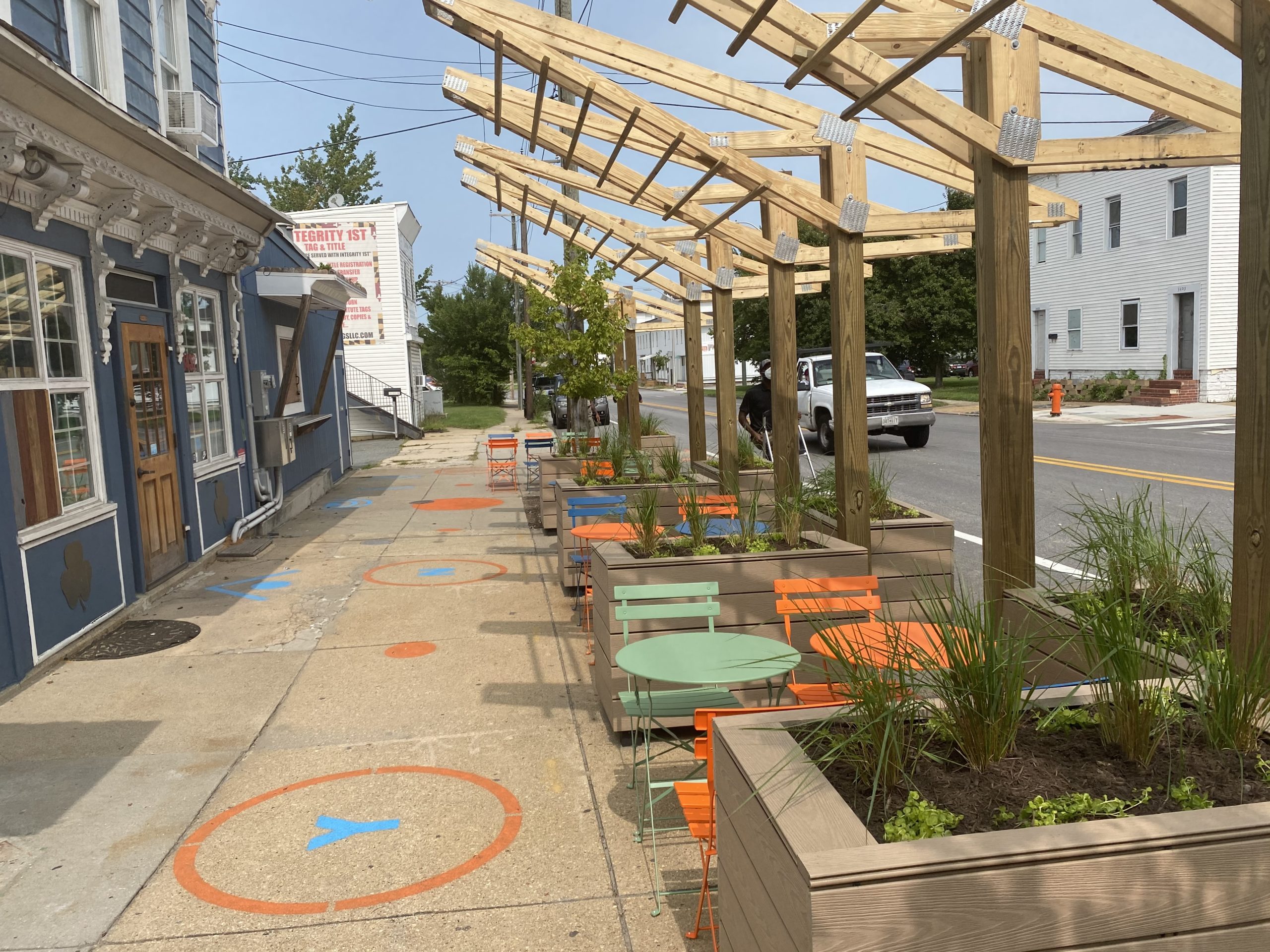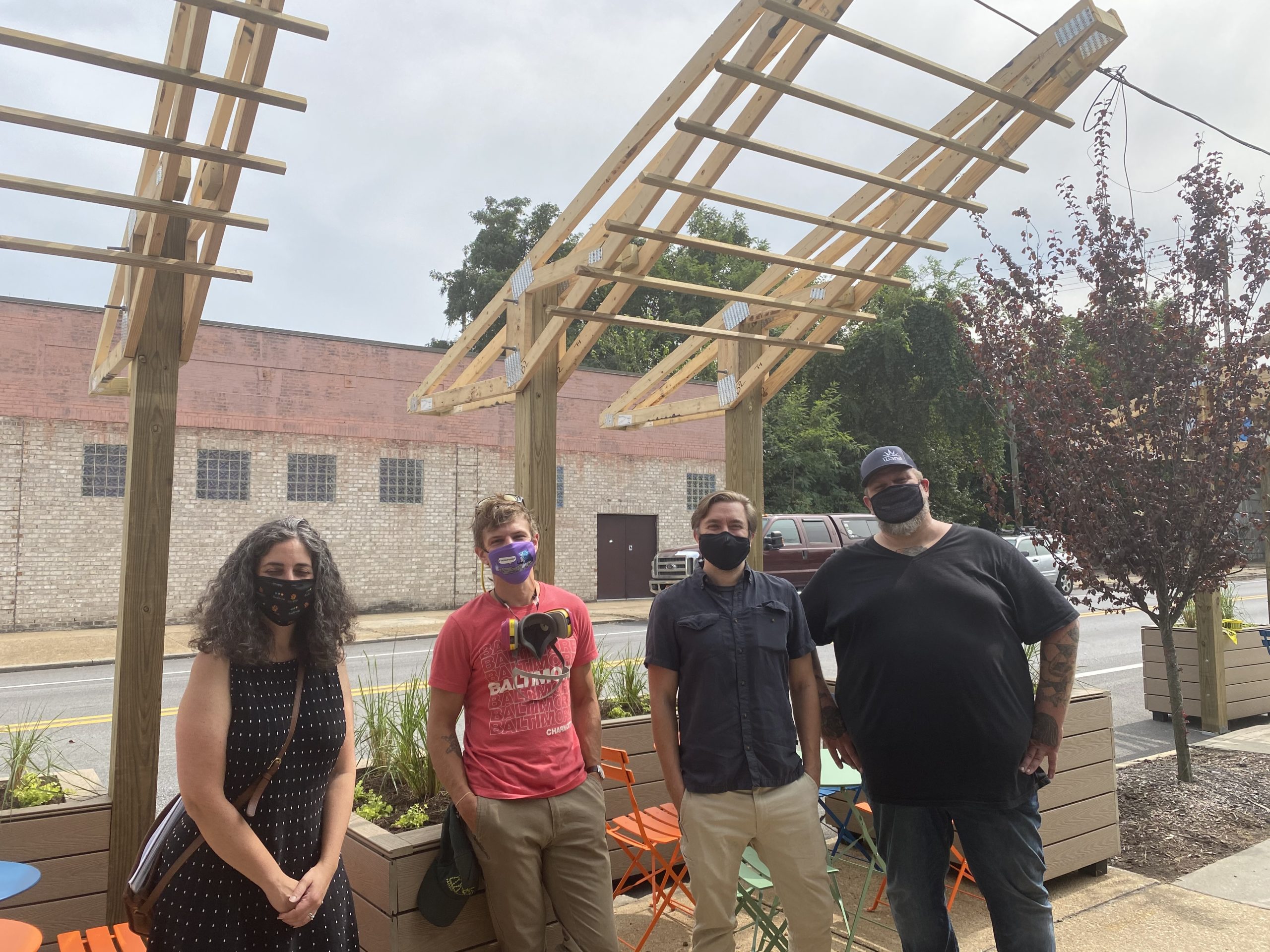When Moshe Berry was driving on Hanover Street past Smoking Swine in South Baltimore’s Brooklyn neighborhood earlier this month, he did a double-take after noticing a recent installation that went up outside the business.
There are nearly 250 colorful sidewalk graphics, some of which say to “Mask Up,” while others mark off spots six feet apart for a service window line at the food and drink spot. It’s giving cues to help maintain distancing, and maintain safety with different folks like deliveries. There’s also a tall truss structure that forms a canopy, which can provide protection from sun and rain. Underneath it are outdoor seating tables separated by planters to help create nooks.
As the installation was completed on a recent Monday, he decided to get out of his car and check it out.
“It completely changes the look of the neighborhood. The neighborhood is really changing in a positive way,” said Berry, a social worker at nearby Maree G. Farring Elementary/Middle School. “You see a lot of involvement from nonprofits … and people are working together.”
The installation is one of several taking shape in commercial areas around the city as part of Design for Distancing. The initiative, which was spearheaded by planning and design nonprofit the Neighborhood Design Center and the city government-backed Baltimore Development Corporation, paired local design teams made up of creative firms to reimagine spaces and local businesses to make room for customers and adhere to the public health restrictions brought by the COVID-19 pandemic.
“These are the kinds of public space amenities that I think small businesses need in general,” said Jennifer Goold, executive director of the Neighborhood Design Center. “We’re able to have this win-win situation where we’re helping small business adapt to a current emergency, but we’re also able to prototype and test how to expand small business into the public realm, to see it in action rather than hypothesize how it’ll work.”

The Brooklyn installation includes a canopy and outdoor seating. (Photo by Stephen Babcock)
After putting together a design competition and releasing an open source guide book with designs, teams are now bringing the installations into Baltimore’s commercial corridors. With grants ranging from $30,000 to $80,000, BDC has looked to prioritize areas with fewer amenities already for bigger projects.
In Brooklyn, Smoking Swine teamed with partners to open a food truck commissary nearly two years ago. Located on the southernmost edge of the city, it’s among the Baltimore neighborhoods that was home to steel workers and other blue collar workers when the city was an industrial engine. Now, a tight-knit group is invested in community-building and making improvements.
“I always thought Baltimore was a diamond in the rough and Brooklyn is definitely that, as well,” Smoking Swine owner Drew Pumphrey said. “It’s one of the only southern neighborhoods that have single family homes abundantly. The architecture here is phenomenal. The people are super nice.”
With initial reopening of food and drink establishments allowed following the pandemic, Pumphrey is now looking to open a bar. The Design for Distancing installation fits with his aim to improve the community: It’s an upgrade from the couple of makeshift tables that were outside the business before, but it also serves a practical purpose.
“We’re limited to 25 inside right now so it effectively doubles our seating capacity,” he said.
Alongside the businesses, the projects are bringing together design teams, companies that handle installation and community partners. In Brooklyn, the latter is community development corporation Greater Baybrook Alliance. The organization had already worked with BDC on a facade grant, and is keen to activate public space.
“This kind of space where people can just hang out and sit quietly. There’s not that many opportunities for people to do that, so we feel really fortunate to have this,” said Greater Baybrook Alliance Executive Director Meredith Chaiken, noting that she and her team are thinking about having meetings at the spot.

Sign of the times. (Photo by Stephen Babcock)
The blend of neighborhood pride and public health messaging is reflected in the design. Along with the graphics for safety, big letters on the sidewalk spell out BROOKLYN with the neighborhood’s blue and orange colors leading up from both sides on the sidewalk.
“We wanted to make sure that we created a gateway on the north end and south end that anchored and celebrated this central core,” said architect Drew Suljak of Fells Point-based Twopoint Studio, which handled concepting and design after being selected in the competition. “We wanted to create this sense of arrival before the bridge and let that make a moment.”
The graphics were painted by Justin Duvall of Justin Duvall Design. Mostly working as a digital designer and illustrator, he teamed with stencil artist Mowgli. One portion of the project involved painting 350 feet of continuous sidewalk.
“It was something new and challenging for me,” he said. At the same time, he said, “I love doing work around Baltimore, and doing work that’s going to benefit the community.”
For Ethan Rambo of Elite Contracting Solutions, which built the installation, “it’s an opportunity to make the neighborhood a little more beautiful.”
Goold said the organizers also hope to learn. They plan to keep talking to customers of the businesses to find out how they’re working, and working on how such tactical interventions could have a more permanent place in Baltimore’s landscape.
“Hopefully once this emergency has passed we will be able to use amenities like this to grow business, grow connection and grow innovation in Baltimore,” she said.
Join our growing Slack community
Join 5,000 tech professionals and entrepreneurs in our community Slack today!
Donate to the Journalism Fund
Your support powers our independent journalism. Unlike most business-media outlets, we don’t have a paywall. Instead, we count on your personal and organizational contributions.





